December 22, 2022
 by Washija Kazim / December 22, 2022
by Washija Kazim / December 22, 2022

When it comes to marketing, you are not your prospect.
You could walk the walk and talk the talk, but at the end of the day, you can’t pitch to an audience without getting to know them first. And nothing prioritizes customer experience more efficiently than inbound marketing.
Inbound marketing provides your customers with precisely what they want, when, and where they need it. It builds trust, loyalty, and authority in your industry in the most organic fashion. While your website and marketing automation software are both crucial components, your success depends on your technology, research, and the strategy you deploy.
From content marketing to search engine optimization (SEO), there is no limit to the creative options you can test for your inbound marketing strategy. And regardless of which tactic you work with, the focus is to empower your audience and persuade buyers.
Inbound marketing is a business methodology that provides quality content and a tailored customer experience to attract prospects and visitors. It does not force products or brands on customers in hopes of generating leads. Instead, it empowers the customer to make the first move.
When customers come to you by choice, you no longer have to give the hard sell. They are already aware of your brand. A successful inbound marketing strategy drives long-lasting connections with your prospects by delivering what they need at different stages of their buyer journey.
In the long run, inbound marketing can drive better results than traditional marketing through improved brand awareness and revenue.
Inbound marketing is a lot like fishing. It’s all about enticing your audience with useful content. Serving this content at precise moments builds awareness and trust for your brand, which means you’re ready to reel them in. Hook, line, and sinker.
The phrase “inbound marketing” was coined in 2005 by the co-founder and CEO of HubSpot, Brian Halligan. It took almost a decade after that for inbound marketing to take off as a concept. Now, it’s as widespread in the online marketer’s vernacular as SEO.
Inbound marketing is a strategic combination of owned and earned media. Owned media is the content you create and control. Earned media refers to content others create that organically promotes your brand. This type of media offers less control, but it's more credible and valuable in the eyes of your audience.
| Owned media | Earned media |
| Blog | Print news |
| Website | Social media mentions |
| Social media handles | Online forum mentions |
| YouTube channel | Product reviews |
| Mobile site | Word-of-mouth |
But how do these two things work together for your marketing strategy?
It’s simple: Inbound marketing uses owned media to garner earned media.
For example, you need content as part of your inbound marketing strategy. You can create it on any of your owned channels. Suppose you write an informative article on your blog. In that case, you could gain earned media by someone linking to it as a reference on their digital news site or a reader posting about it using a social campaign hashtag.
Another example is online reviews of your product or service — you can repurpose reviews to create content for your blog. A solid review strategy can also help you sell more and convert your happy customers into promoters. This unique and focused approach can go a long way in promoting your brand at the right stage in a buyer’s journey.
Again, you’re only offering people valuable information and hoping they take action on their own accord.
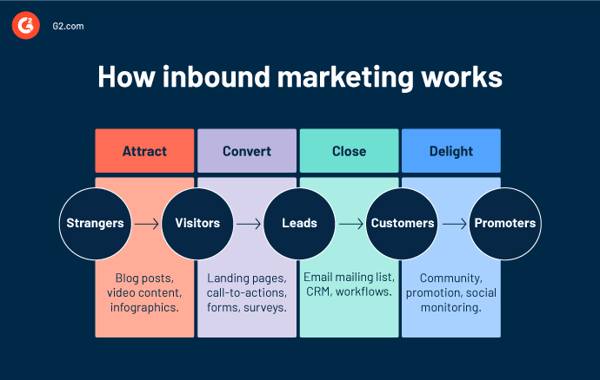
Focusing on the quality of your advertising yields the most promising results, and that’s why inbound marketing works. It’s not about forcing your brand on customers by popping up on every web page they browse. It’s about letting them make informed decisions and being on the top of their minds when they're ready to buy.
When you prioritize customer success, they share their success stories with other prospects, attracting more people to your business and increasing your visibility. A solid inbound marketing strategy establishes a self-sustaining loop that supports your overall marketing goals.
It's important to note that inbound marketing alone is not the most effective solution for your marketing needs. The key is to combine inbound marketing efforts alongside outbound marketing techniques. This mixture will bring long-term success and high returns.
Some debate whether to prioritize outbound or inbound marketing. Both have their upsides, and many brands opt to use both. But what exactly is traditional outbound marketing, and how does it differ from inbound marketing methods?
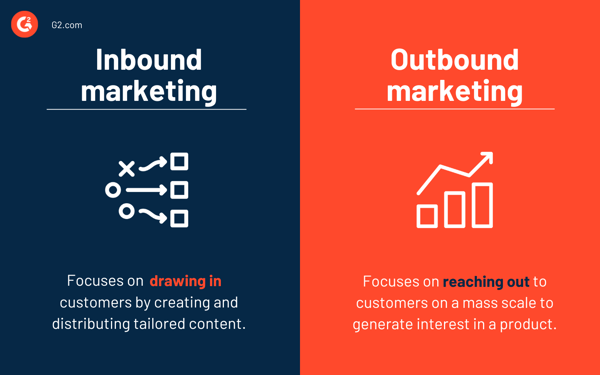
Outbound marketing encompasses conventional methods of promoting a product, such as paid advertising, and can feel aggressive for the modern consumer. It encourages businesses to reach out to prospects actively with a “wide-sweeping” approach in hopes that some will convert. Outbound marketing gets quite linear, as it is limited in how customers can participate in the process and the number of distribution channels.
On the other hand, inbound marketing is more subtle. For B2B marketing, your brand is one of the most valuable assets. So, gaining your audience’s trust is vital. Inbound marketing focuses on educating prospects about your brand, understanding their problems, and then pitching your product right when they are looking for solutions you can provide better than anyone else.
Inbound marketing follows a tailored approach across multiple channels, improving overall results when targeting informed and empowered audiences. The difference is that inbound encourages prospects to willingly engage with your brand rather than outbound forcing ad exposure everywhere they go (billboards, an advertisement in a magazine, banner ads at the top of a topical article).
In short, people seek out inbound marketing while they’re subjected to outbound marketing.
As they say, change is the only constant, and the inbound marketing methodology has evolved over the years. Despite these changes, the core principles of inbound marketing have remained intact.
The five fundamentals of inbound marketing are:
The beauty of inbound marketing is that it works. It’s proven to capture more leads, get more attention, and be a more productive use of marketing resources.
There are many inbound marketing examples, all serving different purposes and obtaining results.
When you’re implementing any of these inbound marketing tactics into your strategy, always make sure you’re keeping your customer in mind. Bring them value before making your pitch. If you can connect the brand and the buyer, customers will regard you as a credible source and a great business.
Let’s go over a few of the most common examples in detail.
Many companies maintain an online blog to publish content adjacent to their mission or purpose. Blog articles are a great example of inbound marketing as they prioritize a reader's wants and needs. They aid customers in learning something unfamiliar, getting insights about industry trends, and staying updated with business events.
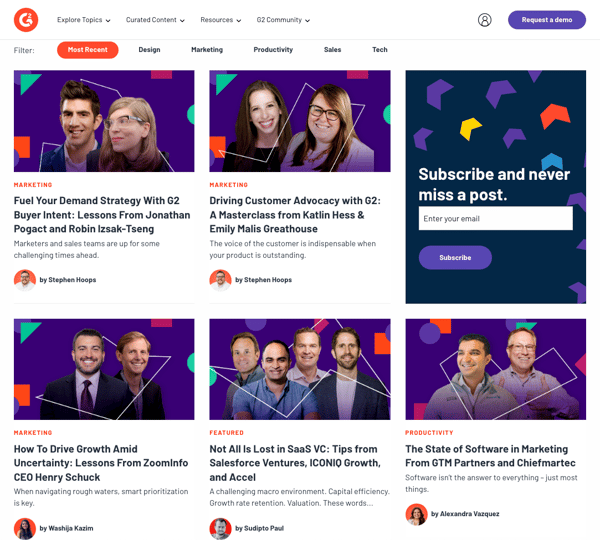
The best thing about writing a blog is that it's incredibly effective, no matter the industry.
Let's say you own a camping and sporting goods store. Instead of writing about your new line of hiking boots, you could write a blog post on hiking essentials for beginners. It works because even though you're not directly promoting your product, you keep the readers interested by offering valuable information. Then, you can provide helpful context about how a good pair of hiking boots can enhance their experience.
And that's what makes blogs so compelling. Your customer is much more likely to trust and favor you if you show them that you care about them, not just their money.
While blogs significantly impact a content marketing strategy, people like to consume content in all forms across the internet. Infographics are an excellent example of inbound marketing for those who gravitate to visual content.
A creative infographic design can enhance your article and help the reader understand the topic more deeply. Even if the reader doesn't go through the entire article, these captivating images provide an insightful snapshot of the different elements of your primary subject. Infographics are an extension of the written content and help reinforce the main point.
Plus, if your article starts ranking on Google, your infographic will likely be found by people searching for your primary keyword. The more informational and easy-to-read your infographic is, the better chance it has of being used as a resource by someone else.
Newsletters have a high potential for growing your customer base and, in turn, your revenue. Circulating a company email newsletter updates your community on the content you create, the products you launch, and general news about your business. Cultivating a tight-knit community of customers can foster loyalty toward your brand as they return to your website for more.
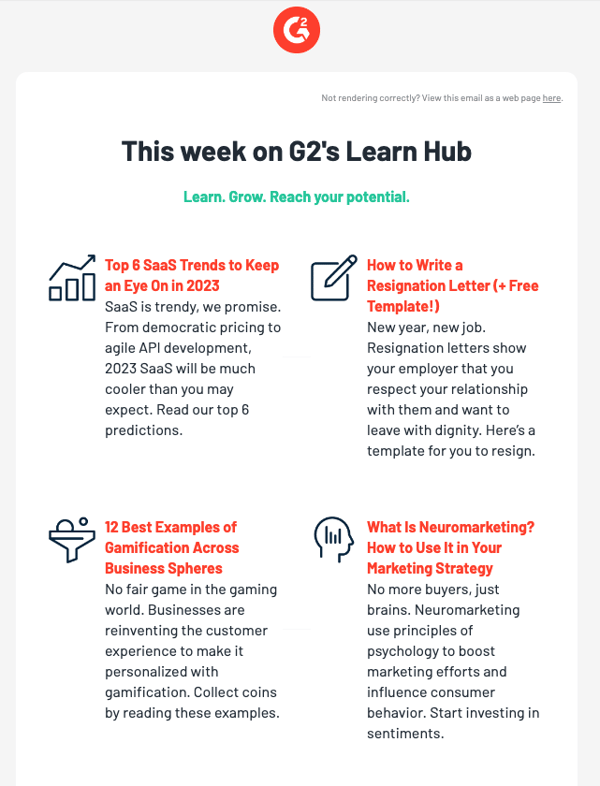
Distribution is the main challenge of content marketing. And email marketing is one of the best channels for broadcasting your content. Use your newsletters as an opportunity to send relevant content to your subscribers. Plus, high-quality content converts readers into informed buyers.
If you let people pick between a 3,000-word article or a 10-minute video, most would go after the video content. Videos are compelling, engaging, and informative. Social media platforms like Facebook, Instagram, LinkedIn, TikTok, and Twitter, are dominated by video content. People love to watch others explain things; this is why developing a video series is an excellent example of inbound marketing.
In its early days, Moz created a video series called "Whiteboard Friday" that gave viewers tips and tricks about marketing, advertising, keyword mapping, and SEO. Since then, the series has grown to millions of views and brings incredible value with tons of free information to SEO professionals.
Additionally, video content is a great way to repurpose blog posts and infographics into a fun format.
of people say they’ve been convinced to buy a product or service by watching a brand’s video.
Source: Wyzowl
Your inbound marketing strategy must be holistic and data-driven. It should attract the right individuals to your brand and convert them into lasting customers.
Let’s dive deeper and discuss some tactics you can implement to reinforce an effective inbound marketing strategy.
A buyer persona is a representation of your target customer, and this representation goes beyond basic demographics. It incorporates psychographic information about the people who purchase and use your product or service.
Start by interviewing customers who have recently made purchases with you. You can ask open-ended questions that reveal more information about them. For example, what does their typical day look like, how much time they spend at work, or what achievements do they carry with pride?
Interview your sales team to understand the types of customers they meet and their reasons for choosing your business over a competitor. You can also discover the most common objections they tend to hear from prospects.
Analyzing buyer intent data is another way to uncover your ideal customers. Considering this data while building out your personas helps ensure the accuracy of your inbound marketing efforts in the future.
While most companies tend to have three to four buyer personas, your first inbound marketing campaign should focus on your primary persona. Concentrating on one will help you tailor your messaging and create a focused campaign across multiple digital channels.
SMART is an acronym for specific, measurable, attainable, relevant, and time-bound. Setting SMART goals is crucial to every inbound marketing campaign because you need to track and measure tangible results to help you plan your next campaign.
When brainstorming content formats, it's best to consult your brand's mission statement. What is the purpose of your brand? What do you bring to the table, and why should people care about it?
Your content formats need to make sense when considering the abovementioned points. Let's say you're a graphic design studio that wants to create in-depth tutorials for your customers. Video content is the first idea that comes to mind. But merely creating videos back to back is not enough. Ensure your content aligns with your brand's mission and your target audience's consumption habits.
Similarly, producing a podcast could significantly heighten your customers' interest if you own an audiovisual equipment company. Making the podcast offers them free entertainment. You could even throw in a few quick ads for your products. Doing this is a less invasive way to market to them and build trust.
There are a variety of content formats that you can choose and play around with.
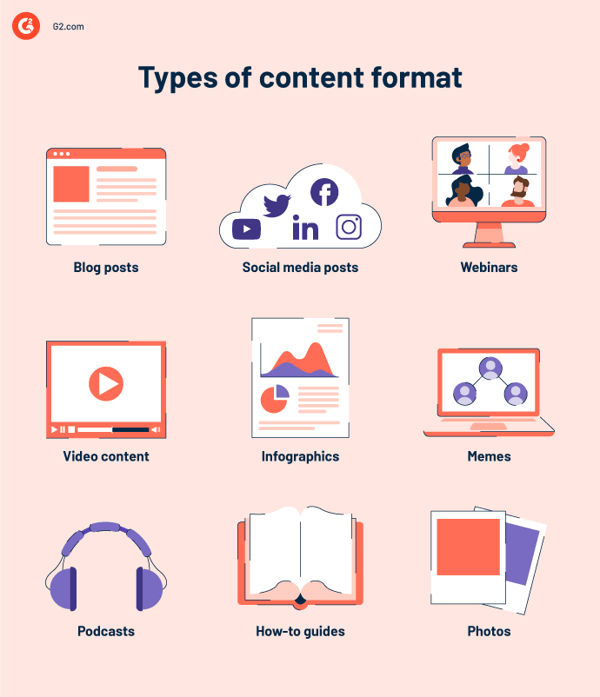
The art of guest posting is a nuanced technique, gaining traction among marketers for quite some time. If your company runs a blog, taking advantage of your connections can help you produce great content with high-quality backlinks.
By offering the option for writers to guest post on your blog, you are simultaneously providing your audience with additional content and fostering relationships with industry thought leaders. More content means there is a higher potential for more people to find it, allowing you to establish yourself as an authority on a subject.
Remember that you can also guest post on other websites. When you share your insights on another company's blog, you can link to your content and get people to visit your web pages.
SEO should be one of the first techniques you pay attention to when optimizing your site. Good SEO practices usually take a while to get right, but the more you try, the better you'll get at it.
A sound SEO strategy can help you drive a significant amount of traffic to your site and help you capture potential customers. Learning how SEO impacts traffic, leads, and conversions is a great place to start as a beginner. For example, using the appropriate keyword with supporting keywords can give you the boost you need to rank on the first page.
You could be writing the most resourceful articles on your blog, but if people aren’t reading them, the effort is wasted. So, creating a social media strategy to distribute content should be your next step.
Start by reviewing your analytics on Facebook, Instagram, Twitter, and even YouTube (if your brand focuses heavily on video content marketing). Accessing this unique data can help you discover your target audience's interests and social media habits. Doing so will enable you to make informed decisions on which social media channels are perfect for reaching them.
Moreover, social media management software can help you better understand the best places and keywords to engage with your ideal customers.
An effective conversion path consists of a call-to-action (CTA), a landing page with a form, a thank-you page, and a corresponding thank-you email. Take the time to scrutinize your landing page. Your target customer will use this to determine if your content is worth providing their contact information.
When in doubt, remember the three Bs of landing page optimization:
Once the users have submitted the form, direct them to a thank-you page. This is another opportunity to engage your buyer persona by offering them a unique page copy and other resources they might find valuable.
A follow-up email is essential, especially when prospects consume content via mobile devices. That vendor comparison report your buyer persona just downloaded is helpful to them, so help them keep track of it. Your thank you email must deliver helpful content to their inbox.
Your inbound marketing strategy aims to generate leads from your persona-based marketing campaigns. Once you have these leads, it's time to follow up in a beneficial, educational way.
Segment your database of leads and create targeted lists aligned to your personas or different stages of the buyer's journey. It will support your framework of what content to serve to these leads based on where they are in their buying journey.
It's great to feature your new content in your website's resource library. However, your inbound marketing strategy should also include a promotional email to your contacts that would benefit most from relevant content.
The easiest part about building this email campaign is that you've already done the hard work by writing the content and creating a landing page. So, your copy on the landing page should work well for your email copy.
There's no "one-size-fits-all" approach to a solid inbound strategy. The beauty of digital marketing is that you can A/B test, so don't be afraid to experiment with content topics, formats, and channels.
Marketing automation platforms feature robust analytics that you can use to monitor your inbound marketing efforts. Try to identify what efforts are or aren’t generating results. Ultimately, you can learn and create even better, more effective campaigns the next go-around.
And once you have analyzed campaign performance, you can brainstorm inbound marketing ideas to enhance the actions that bring in results and deactivate what brings no profit.
Here are a few key metrics to track your inbound marketing efforts:
Inbound marketing puts your brand forward as a helpful thought leader and a trusted source of guidance and information. The content you've produced is available 24/7, which makes it an accessible version of customer support.
With inbound marketing, you increase brand awareness across a wider audience by creating excellent content. For instance, someone might share your content on their social media account, putting you in front of even more eyes, and increasing your chances of sourcing potential customers for your products or services.
Outbound marketing campaigns can be costly and risky. With inbound marketing, the content you create lasts forever. So, you can continuously share and optimize your content library and create a focused strategy for promoting your brand, boosting return on investment (ROI) over time.
Most eyes you catch will not be at the buying stage of the sales funnel. By guiding people to your company website, you can collect information to engage them. Through continuous engagement, you build that trust as a resource and provide an offer to sell when the time is right.
Marketers often wonder why conversations are important in an inbound strategy. Conversational marketing matters because it delivers content in a manner that is consistent and relationship-focused. It reinforces one-on-one interactions across multiple channels, resulting in improved customer relations.
The modern consumer is all for learning about a product and making informed decisions. As a result, they will most likely search for more information about the product or service you are offering. You can strategically distribute your content with proper research and defined buyer persons.
Inbound marketing methods are perfect for nurturing relationships with your customers, which allows you to generate more qualified leads. Creating content that resonates with your audience’s pain points will attract quality traffic to your website and guide them toward conversion.
Inbound marketing is about playing the long game, but building trust with your audience will lead to meaningful engagement, qualified leads, and higher conversions.
Andy Crestodina
Co-founder and CMO, Orbit Media Studios
It's easy to put inbound marketing on a pedestal because when it works, it works. But there are some things to consider before you dive headfirst into these efforts.
You must execute an effective inbound marketing strategy with the right tools. Not doing so can cost you time and money - and even potential customers. It would be best if you found tools that work well for your strategy and with each other. If your software is not well integrated, you will be stuck doing repetitive tasks or losing data in the process.
If your C-suite loves asking "show me the ROI" to prove your worth, inbound might be a tough sell. There might be several reasons behind it. For instance, some campaigns don't tie to revenue directly, or there might not be a standardized method for calculating marketing expenses. As mentioned above, inbound marketing is a long game.
Inbound marketing requires investment. You must assemble a content marketing team, work on a solid SEO strategy, and build business relationships. Plus, creating a repository of valuable content, performing A/B tests, and being recognized by Google as a credible source takes time.
And even if you have time to invest, it's easy to get discouraged, wondering if the strategy is correct, if the content is good enough, and if the team you hired was the proper use of resources.
Marketing automation software is perfect for automating your sales and marketing efforts to generate more leads, close more prospects, and measure your outcomes more effectively.
This tool is ideal for inbound marketers to bridge the gap between an engaged visitor and an actual conversion, which is the last step in the inbound marketing funnel. Companies need to adopt this technology for more than automating email communication.
Effective marketing automation software will:
Irrespective of what ingredients you add to your inbound marketing strategy, remember to keep the customer first. Once you connect your brand with your buyers, you’ll be regarded as a trustworthy source, leading to a loyal audience who will also be your biggest promoter.
And that's the beauty of inbound marketing; it’s a reliable method of bringing awareness to your brand and fostering relationships with potential and current customers. Once you have a strong strategy in place, you will grow your business by getting customers to buy more, nurturing those relationships to last longer, and benefiting from the best word-of-mouth.
Ready to make the most of inbound marketing? Start by learning the basics of creating a content marketing strategy.
Washija Kazim is a Sr. Content Marketing Specialist at G2 focused on creating actionable SaaS content for IT management and infrastructure needs. With a professional degree in business administration, she specializes in subjects like business logic, impact analysis, data lifecycle management, and cryptocurrency. In her spare time, she can be found buried nose-deep in a book, lost in her favorite cinematic world, or planning her next trip to the mountains.
An inbound marketing strategy is holistic, data-driven, and aims to attract the right...
 by Jen Spencer
by Jen Spencer
Curating a marketing strategy isn’t an easy feat, but it’s certainly not impossible.
 by Alexa Drake
by Alexa Drake
So you’ve been in the marketing game for a while and revamping your strategy is second nature.
 by Alexa Drake
by Alexa Drake
An inbound marketing strategy is holistic, data-driven, and aims to attract the right...
 by Jen Spencer
by Jen Spencer
Curating a marketing strategy isn’t an easy feat, but it’s certainly not impossible.
 by Alexa Drake
by Alexa Drake


